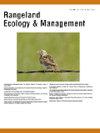Effectiveness of a Wireless Transmission System in Searching for Hidden Calves in Grazing Land
IF 2.4
3区 环境科学与生态学
Q2 ECOLOGY
引用次数: 0
Abstract
Searching for hidden calves in grazing lands is a great burden for herders, although the hiding behavior of calves is important in animal welfare. Recently, wireless transmission services for mountain rescue have attracted considerable attention and the services have branched out into the pet rescue field as well. The transmission device does not utilize global navigation satellite system (GNSS) or internet communication, but only emits a radio signal that can be received by a specific receiver within a specific distance. Therefore, the device is lightweight and can be used for a relatively long time without recharging. We evaluated the effectiveness of the wireless transmission system in reducing the labor required for herders to search for hidden calves in grazing lands. The search trials were conducted in four paddocks (4.8–5.1 ha), which were located on an uneven terrain in the mountains, consisting of pasture and wood sections; therefore, these paddocks were under poor visibility conditions for cattle search. Using a dummy calf that imitated a 1-week-old calf, we performed a total of 40 search trials (five trials each with and without device support in each paddock), and compared the moving distance (search distance) and searching time, with and without device support. Moreover, we conducted 30 search trials using three Japanese Black calves fitted with the devices, to demonstrate the effectiveness of the device support. In the search trials involving dummy calf, the use of the device significantly reduced the moving distance and searching time. In the 30 search trials involving actual calves with device support, hidden calves were found using only the device's indications. There were no device failures or the collars falling off. Therefore, the wireless transmission device is useful for searching for hidden calves in grazing lands.
无线传输系统在牧场寻找隐藏小牛中的有效性
尽管小牛的隐藏行为对动物福利很重要,但在放牧地寻找隐藏的小牛对牧民来说是一个很大的负担。近年来,山地救援无线传输服务备受关注,该服务也已扩展到宠物救援领域。发射装置不利用全球卫星导航系统(GNSS)或互联网通信,只是发射特定距离内特定接收器可以接收的无线电信号。因此,该设备重量轻,可以在不充电的情况下使用较长时间。我们评估了无线传输系统在减少牧民在牧场寻找隐藏小牛所需的劳动力方面的有效性。搜索试验在四个围场(4.8-5.1公顷)进行,这些围场位于山区不平坦的地形上,由牧场和林区组成;因此,这些围场的能见度很低,不适合找牛。使用模拟1周龄犊牛的假犊牛,我们共进行了40次搜索试验(每个围场有设备支持和没有设备支持各5次),并比较了有设备支持和没有设备支持时的移动距离(搜索距离)和搜索时间。此外,我们使用装有该装置的三头日本黑牛犊进行了30次搜索试验,以证明该装置支持的有效性。在涉及假犊的搜索试验中,该装置的使用显著缩短了移动距离和搜索时间。在30个使用设备支持的真实小牛的搜索试验中,仅使用设备的指示就发现了隐藏的小牛。没有设备故障或项圈脱落。因此,无线传输装置对寻找牧场中隐藏的小牛很有用。
本文章由计算机程序翻译,如有差异,请以英文原文为准。
求助全文
约1分钟内获得全文
求助全文
来源期刊

Rangeland Ecology & Management
农林科学-环境科学
CiteScore
4.60
自引率
13.00%
发文量
87
审稿时长
12-24 weeks
期刊介绍:
Rangeland Ecology & Management publishes all topics-including ecology, management, socioeconomic and policy-pertaining to global rangelands. The journal''s mission is to inform academics, ecosystem managers and policy makers of science-based information to promote sound rangeland stewardship. Author submissions are published in five manuscript categories: original research papers, high-profile forum topics, concept syntheses, as well as research and technical notes.
Rangelands represent approximately 50% of the Earth''s land area and provision multiple ecosystem services for large human populations. This expansive and diverse land area functions as coupled human-ecological systems. Knowledge of both social and biophysical system components and their interactions represent the foundation for informed rangeland stewardship. Rangeland Ecology & Management uniquely integrates information from multiple system components to address current and pending challenges confronting global rangelands.
 求助内容:
求助内容: 应助结果提醒方式:
应助结果提醒方式:


